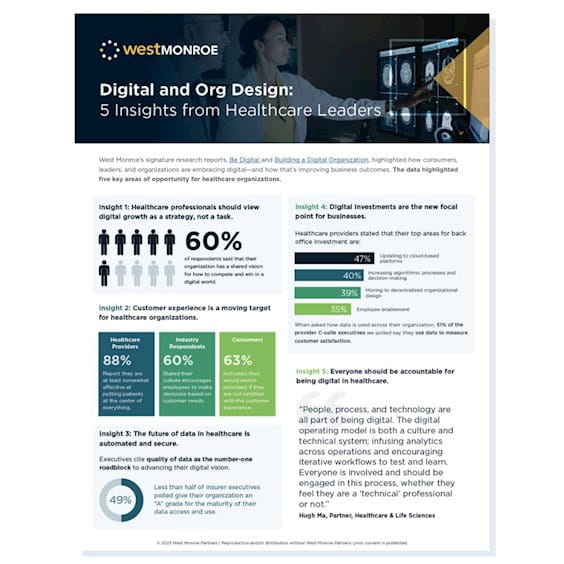Digital and Org Design: 5 Insights from Healthcare Leaders
Key areas of opportunity across people, process, and technology at the start of 2023
The future of healthcare is digital. Telemedicine and online pharmacies continue to impact existing industries while legacy healthcare payers and providers are making strides to create digitally agile organizations. While some organizations are well on their way toward a digital operating model, there is still considerable progress to be made in aligning with customer/patient priorities, curating a digital mindset, and leveraging data as effectively as possible.
West Monroe’s signature research reports, Be Digital and Building a Digital Organization, highlighted how consumers, leaders, and organizations are embracing digital—and how that’s improving business outcomes. The data highlighted five key areas of opportunity for healthcare organizations.

Insight 1: Healthcare professionals should view digital growth as a strategy, not a task
Rather than treating digital as a temporary line item, healthcare organizations should emphasize the importance of an organization-wide, digital-first mindset. Just as an organization is constantly pursuing strategies to grow and strengthen, digital is an ongoing journey, not a once-and-done task.
When it comes to the back office, 94% of health insurers are moving to a decentralized organizational design, allowing ideas to come from anywhere and ensuring the customer voice is heard throughout planning, implementation, and post-launch monitoring. There continues to be room for enhancing organizational cultures to support agile workflows, cross-team collaboration, and decentralized decision-making.
94% of health insurers are moving to a decentralized organizational design
A majority of organizations are headed in the right direction—60% of respondents said that their organization has a shared vision for how to compete and win in a digital world. But this still leaves room for improvement.
Action: Start by establishing a baseline: how are teams currently embracing digital? What is the ideal workflow and experience? Then work on breaking down siloes and centralizing data for broader use across the organization.
Insight 2: Customer experience is a moving target for healthcare organizations
For health insurers and providers, customer and patient experience focuses largely on convenience, accessibility, and simplicity—the three largest non-negotiables in the healthcare industry. But how do organizations stack up at making sure customers and patients are satisfied?
Most healthcare providers (88%) report they are at least somewhat effective at putting patients at the center of everything, and a majority (60%) of healthcare industry respondents stated their culture encourages employees to make decisions based on customer needs.
But consumers have an advantage on their side: the ease with which they can switch from one healthcare provider to another. More than half (63%) of consumers indicated they would switch providers if they are not satisfied with the customer experience. It is important for insurers to stay on their toes, remaining responsive to the needs and expectations of existing customers and adding features and products to attract new ones. As consumers grow more comfortable with virtual health monitoring and consultations, providers will need to become more channel agnostic in a hybrid world.
Action: Seek insights and behavioral habits from patients and customers. Leveraging this data will help identify priorities and ultimately provide a stronger experience, leading to longer-term retention.
Insight 3: Digital investments are the new focal point for businesses
Digital businesses prioritize data over past performance or gut feelings to inform strategy and action. Getting to that point starts with the right infrastructure—cloud-based and connected—and extends to how organizations use data.
West Monroe’s research indicates that healthcare providers are maximizing the cloud, with nearly two-thirds (65%) reporting it constitutes the majority of their infrastructure. In addition to the proven ROI from a cloud-based infrastructure, executives rated “increasing scalability” as the most important priority for growth over the next three years. Providers (78%) say their infrastructure is flexible to patient and business needs and is also scalable to meet future needs, but much work remains.
After years of investing heavily in clinical systems, healthcare providers are now paying more attention to back office operational systems. Cloud-based platforms and algorithmic processes and decision-making are two major focal points for back office digital investments over the next year.
Healthcare providers stated that their top areas for back office investment would be:
-
Updating to cloud-based platforms: 47%
-
Increasing algorithmic processes and decision-making: 40%
-
Moving to decentralized organizational design: 39%
-
Employee enablement: 35%
-
When asked how data is used across their organization, 51% of the provider C-suite executives we polled say they use data to measure customer satisfaction
Action: Identify tasks and efforts that are inefficient—could a digital solution support this effort? Benchmarking can help identify areas of opportunities and places to further embed digital throughout the organization.
Insight 4: The future of data in healthcare is automated and secure
Companies use artificial intelligence (AI) and machine learning (ML) to get a deeper, more dynamic, and more timely view into medical costs, as well as to streamline claims handling and improve customer service. Understanding the potential of cloud AI and ML, it’s no surprise that 98% of health insurers expect to invest in increasing algorithmic processes and decision making in the next year. Executives cite quality of data as the biggest roadblock to advancing their digital vision, and less than half (49%) of insurer executives polled give their organization an “A” grade for the maturity of their data access and use.
Executives cite quality of data as the number-one roadblock to advancing their digital vision.
As the industry continues working to incorporate telehealth and remote monitoring for the long term, the associated risks must be tightly managed. With the frequency and severity of data breaches and ransomware attacks escalating, providers must continuously adapt to protect their patients’ information. Malicious actors can threaten to bring operations to a halt, putting patient lives at risk. The future of data in healthcare will inherently be digital, requiring another layer for security.
Action: Take steps toward centralizing data to make it more accessible for drawing insights, taking stock of security measures in place along the way.
Insight 5: Everyone should be accountable for being digital in healthcare
Across the entirety of an organization, it’s imperative that everyone plays their part in being digital. The success of a digital strategy largely depends on the backing and involvement of the individual people within an organization. In healthcare organizations, it’s not always clear who is responsible for digital strategy, with only 37% of health provider respondents assigning responsibility to the full C-suite for their organization’s digital vision and execution.
And, surprisingly, health providers cite IT as one of the top teams inhibiting digital vision in healthcare (41%). These teams are usually stretched beyond capacity and may not always see eye-to-eye with other parts of the business about crucial changes to be made. But to execute large-scale changes necessary across the organization, every individual—from the compliance department to clinicians—should have clear responsibilities tied to bringing the digital vision to life.
Action: As teams embrace digital at every level, it’s important to communicate the vision and define responsibilities and expectations for leaders and their teams, with digital at the center of what they do.
Conclusion
Digital businesses make a point of establishing multidisciplinary teams that bring diverse perspectives to the table to inform strategy and drive it forward. For healthcare organizations to fully embrace a digital operating model, they will need to engage teams that include members from a variety of business functions and disciplines—clinical and non-clinical alike—to better sense, analyze, and quickly respond to changing conditions using secure technologies, platforms, and a formalized data strategy.
There is a need moving forward to evolve automation and digitally powered processes so that human efforts are focused on business differentiators and patient care, ultimately enhancing efficiency, empowering employees, and streamlining efforts. Making that mindset shift to see technology as a growth driver versus a cost center will have long-term benefits and better support customer, provider, and patient needs.



